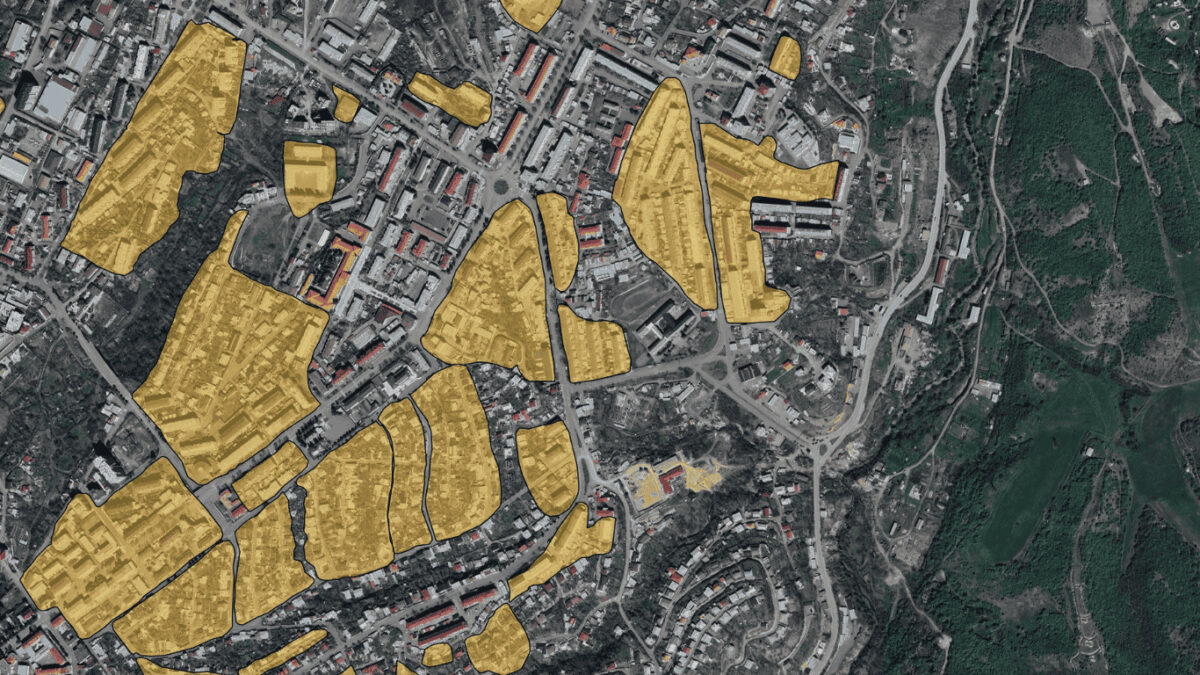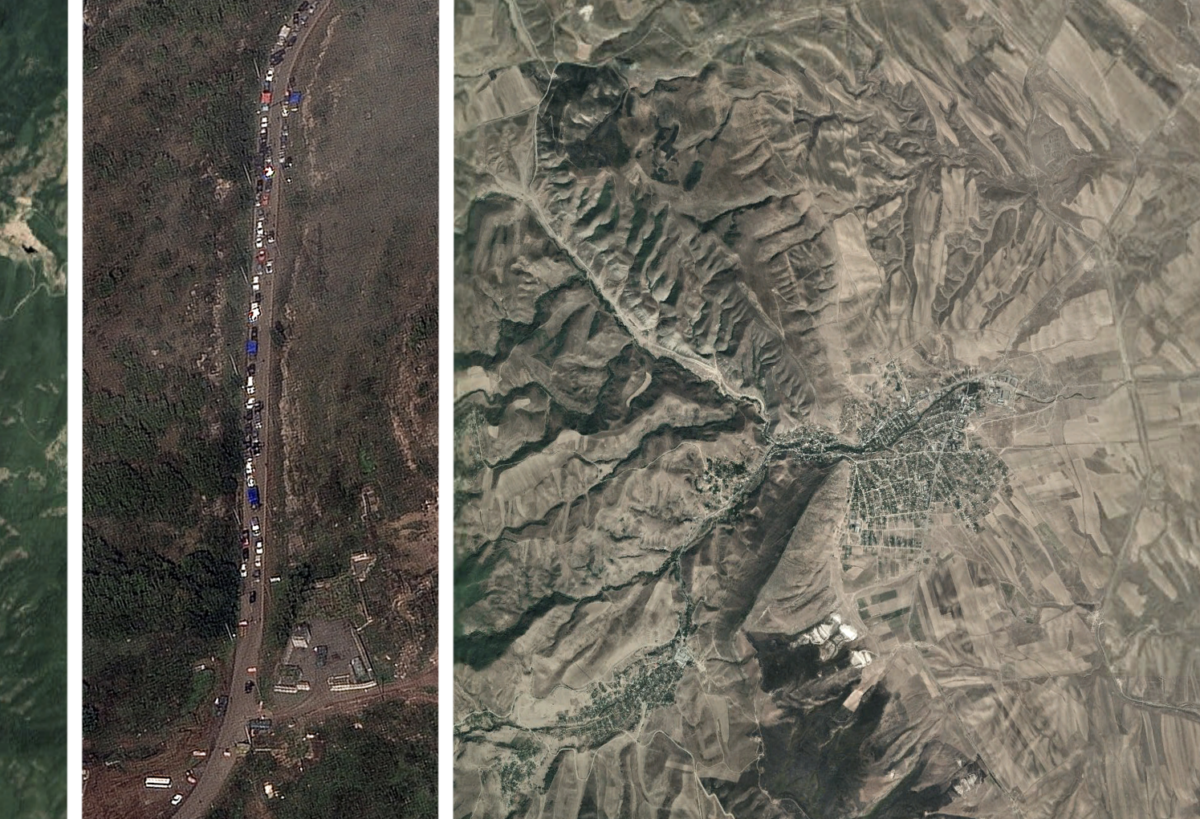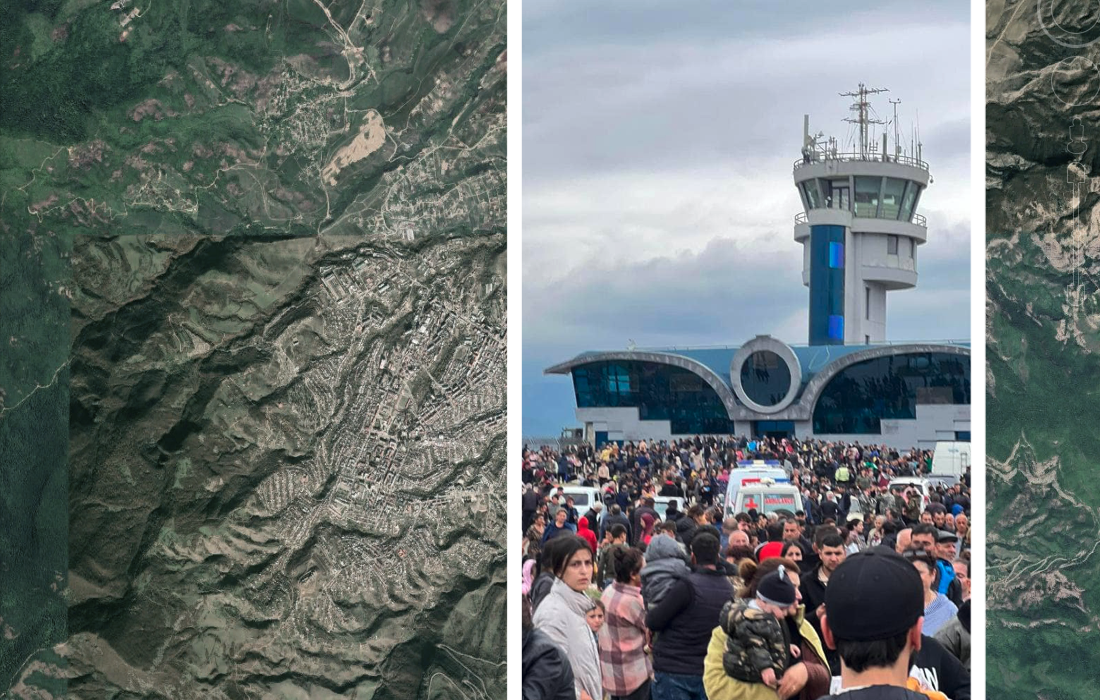Azerbaijan and Israel's Aerospace Industry. A Worrying Concern for Armenia or Iran?
The border of Nagorno Karabagh, one of the most militarized borders in Europe, attracts attention from think tanks, European organizations and major powers. The frontline between Armenia and Azerbaijan replicates WW1 style trenches and its distance between the two opposing trenches in certain sections are a mere 500 metres in distance. Azerbaijan’s official rhetoric has reached the point of declaration of war on a number of occasions, and policies set by these institutions fail to take into account this threat. Azerbaijan’s rapid militarization threatens regional stability, but has largely escaped the attention of the major powers while its major procurements are catapulting its military to frightening levels.

The above photo depicts opposing trench systems on the frontline, with the yellow place mark representing the middle distance between the two trenches. The white arrow represents the Armenian side and the red arrow representing the Azerbaijani side. This distance between the two trenches approximately 500 metres apart. (Photo Courtesy Google Earth)
Israel’s aerospace industry, one the world’s leading suppliers in military technology, has increasingly cooperated in the sphere of arms sales with Azerbaijan. The game of geopolitics played by major powers dictates the constraints that regulate spheres of influence. This means moderating smaller nations such as Azerbaijan to keep strategic balance and a tight control over advances that might threaten stability. This tight control is always coupled with the strategic interests of major powers. The friendship between Israel and Azerbaijan has overstepped these constraints. Close observation will provide institutions with analysis on Azerbaijan’s rapid military advances.
Military hardware technology transfers from Israel to Azerbaijan have increased, and these military procurements threaten the delicate balance between Armenia and Azerbaijan previously maintained by the major powers. Bellingcat has closely followed many of the advances made by Azerbaijan in its military potential. Restraints on Azerbaijan’s procurements do exist and Russia’s reluctance to sell advanced S300s to Iran could be one factor that keeps Israel somewhat hesitant in its relationship with Azerbaijan. In spite of these restraints and the slow process in acquirement, advances in technology nevertheless continue to be made by Azerbaijan, with many of these from Israel’s Aerospace industry and Elbit systems.[1]
Armenia’s military advisors have been preoccupied with Azerbaijan’s UAV purchases from Israel. UAVs have captured world attention because of their capacity for air strikes and for transferring real time information. US strikes in Pakistan and the UAV’s ability to assist in ground operations for troops in Iraq have taken warfare to new levels. Many think tanks and institutions have been aware of Azerbaijan’s purchases of Israeli made unmanned vehicles. Bellingcat, who has been tracking developments in Azerbaijan’s rise in military capacity, has kept a close eye on purchases on UAV’s as well as advances in SIGINT and ELINT systems.
SIGINT Signal intelligence and ELINT Electronic intelligence in particular suites in electronic warfare capabilities are a major concern for Armenia. Bellingcat has been aware of advances in basic jammers available in the Azerbaijani inventory, as well pursuits in electronic warfare research programs, procurements and hiring of technicians in the field. Upgrades such as this will inevitably take Azerbaijan into the next level of warfare, real time; live tactical, information quality and most of all jamming technology.
Israel’s advances in its electronic warfare technology are the most advanced and battle proven in the world. Their air defence suppression techniques, in which Israel’s exploitation of Russian air defence systems, have in past conflicts totally jammed Russian surface to air missile systems.[2] In 2007 the Israeli jet strikes on a suspected nuclear facility in Syria proved Israeli dominance over the sky. Various reports mention Israeli jets entering Syrian air space, according to IMINT analysis, Israeli jets circumvented air space to avoid air defence systems nonetheless Syrian targets where hit[3]. These battles and other subsequent capture of technology have provided Israel with fine technology to manipulate. S300PMU-2, the most advanced air defence systems in the world stationed in Baku, can pose a technological threat to Armenia if Israeli scientists help Azerbaijani counterparts design electronic counter measures. Russia’s sale of the S300PMU2 definitely accounted for this risk, selling downgraded technology to Azerbaijan or stationing its own personnel with Azerbaijani’s on the system.[4]
Currently, Azerbaijan lacks technology such as delivery platforms and SIGINT and ELINT systems, precluding it from attempting high-end electronic warfare. Even without the S300PMU-2 being manipulated for technology, basic advances in electronic warfare with Azerbaijan’s military could amount to jamming Armenian air defence systems. Certain purchases from the Israeli Aerospace Industry, such as the Green Pine Air Defence Radar, and further interest in the area of electronic warfare will lead to advances.
To Armenia’s detriment, no current imagery to date has found any defensive ground based jammers in the country. What is interesting is that Russia’s technology also has had major advances in electronic warfare, which raises the question as to why Armenia has been reluctant to purchase such equipment from Russia. Russia’s shift in strategic interests and further deteriorating relations between Armenia and Russia, which has seen ongoing problems, could amount to the increase in technology transfers between Israel and Azerbaijan. Nonetheless Azerbaijan’s basic upgrade packages to date are still concerning and can ultimately lead to the next level of procurements and technology base.
Upgrades for SU-25 from Israel’s Elbit systems provide various technological advances on old Soviet jets with jamming pods, evasive manoeuvre techniques against air defence missiles and upgraded missile delivery systems with glass cockpit helmets, all optimized specifically for the SU-25, making it a sound ground attack plane[5]. Azerbaijan’s options in SU-25 upgrades remain open; Georgia has offered a joint production with Azerbaijan for the SU-25 at the Tbilisi Aerospace manufacturing plant with Azerbaijan offering to fund the project, which will inevitably entail Israeli assistance. Russia’s Ulan-Ude aviation plant has rejected offers of upgrades for unknown reasons.[6] Other options include direct upgrades from Israel’s Elbit systems for the fleet of SU-25s. Geo-politics dictates military sales, and while Azerbaijan’s appetite for SU-25 upgrades has encountered problems due to various factors, these available options can still provide the required upgrades needed.[7]
Recent confirmed developments in Azerbaijan point to the building of new shipbuilding facilities – the first time a Caucasus nation has developed its own military industry on this scale since the fall of the Soviet Union. Israeli assistance has guided Azerbaijan in its efforts towards an indigenously developed ship factory that is able to rebuild their border patrol ships and conduct upgrades.[8]Israeli “Spike” anti-tank missile systems have been test fired off the Azerbaijan coast on the Shaldag MK patrol boats. These are a fourth generation missile made in Israel – one of the most advanced fire-and-forget systems that leave Armenian anti-tank missile systems a generation behind. These systems have only been showcased on the coast and not yet spotted on the frontline. Bellingcat will keep an eye on available imagery close to the frontline. This new weapon system is a major concern for Armenia[9], and fourth generation equipment in Azerbaijan’s inventory is a wakeup call for the Armenian military. Azerbaijan’s advances have been prompt and the acquisition of relevant technology is moving at a decent pace. Taking into consideration Armenia’s passivity in regard to technological advances, Azerbaijan has closed the gap and has far exceeded Armenia’s military strength.

Picture President IIham Aliyev and the new revamped state boarder service coast guard ships at the ship building facility. Note ship on dry dock platform. (Spike missile top right centre).
The technology transfers to Azerbaijan not only give Israel a foothold in the region, but can also play a major role in any attack on Iran. At this time, analysts are looking for basic ground based jamming systems in available imagery in Azerbaijan and Bellingcat is keeping an eye on these developments as well. Ground based jammers will provide Israel’s air force with open air space, jamming Iranian air defence systems and taking them out with anti-radiation missiles. These systems can ultimately be used against Armenia, as a two pronged policy by Azerbaijan protecting itself against Iran and developing technology from Israel’s defence firms in preparation for the next conflict against Armenia.
Other systems, such as target locating and fire control systems are the next step in Azerbaijan’s military requirements. These systems, if combined with Azerbaijan’s current air defence systems – one of the most advanced in the world – could minimize the retaliatory strategy of Iran’s attack against Azerbaijan. Iran’s option of an attack on the oil fields of Baku in retaliation against a strike from the West is still an option, but becoming increasingly difficult due to Azerbaijan’s advances in technology. Azerbaijan’s advances could also prevent major powers from intervening in the next conflict between Armenia and Azerbaijan – a possible scenario considering NATO’s involvement in the Yugoslav wars.
Azerbaijan’s wish list is not far from reality and Israel’s strategy against Iran is not far behind the rise of Azerbaijan’s military, with both countries playing the game for their own interests. Even without the Israeli air force being allowed access to air bases in Azerbaijan, Israel’s involvement in the Caucasus is a threat for both Armenia and Iran. Israel’s foothold in the region will provide Azerbaijan with the capacity to develop technology that can surpass Iran’s technological level in the coming future, which is Azerbaijan’s ultimately military goal. The latest round of military procurements has not only tilted the scales in favour of Azerbaijan, but has started a whole new arms race in the region. Armenia’s military leadership needs to reconsider its options, Iran needs a closer look at its foreign policy towards Azerbaijan and Europe needs to address an new age of technology in the Caucasus.
[1] Green Pine Radar on order. UAV have been also spotted confirming the latest round of purchases. http://defense-update.com/20120603_russia-southern-republics-opt-for-israeli-uavs.html#.VUMUzJOMYrc
[2] Israel jammed Egyptian Kub SAM systems during the Arab Israeli conflict. See Air Power Australia “Surface to Air missiles in past Conflict” Dr Carl Kopp http://www.ausairpower.net/APA-SAM-Effectiveness.html
[3] O’Connor, Sean (2010). “Syrian Strategic SAM Deployment”, 7th January, IMINT Analysis, http://geimint.blogspot.com.au/2007/09/syrian-sam-network.html.
[4] Russian personal have not been seen with Azerbaijani on S300 systems and leaks have reported that the S300PMU-2 are fully operational. Photo imagery http://www.militaryphotos.net/forums/showthread.php?137251-Military-of-Azerbaijan/page127
[5] https://www.elbitsystems.com/elbitmain/area-in2.asp?parent=169&num=174&num2=174
[6] OSIMINT (2013). “Georgia offers Azerbaijan Joint production of SU-25”, 3rd May, http://osimint.com/2013/05/03/georgia-offers-azerbaijan-joint-production-of-su-25/.
[7] OSIMINT, op. cit. Russia’s pro Armenian stance could be a reason for Ulan-Ude aviation plant rejecting offers for upgrades.
[8] Dunai, Peter (2014). “Azerbaijan Inaugurates Shipbuilding facility”, 22nd July, http://www.janes.com/article/41108/azerbaijan-inaugurates-shipbuilding-facility.
[9] See Herschelman, Kerry 2014). “Azeri Coast guards revamp fleet with Israeli help”. IHS Jane’s 360, 28th August, http://www.janes.com/article/42534/azeri-coastguard-revamps-fleet-with-israeli-help. Test firing of Spike missiles is confirmed in imagery. http://www.militaryphotos.net/forums/showthread.php?137251-Military-of-Azerbaijan/page136


